The time is upon us once again to ASK…THE QUESTION, what we do here in our monthly column where we take your pressing mysteries of the DC Universe and provide answers to the best of our ability. I’m your host to the inexplicable, Alex Jaffe, better known in the DC Community as HubCityQuestion, and no, your eyes do not deceive you, this IS the second ASK…THE QUESTION column this month. We’re doubling up for July as a little Comic-Con treat (and because my editor really wants to be done with the extraterrestrial encyclopedia that we’ve been making our way through for much of the year).
Remember, if you’d like to submit a question of your own for a future column, you can stop by my office at any time in the DC Community to make your inquiries, each of which I will in time address to the best of my ability. Otherwise, read on for this installment’s answers!
Encyclopedia Extraterrestria, Vol. 6: U-Z
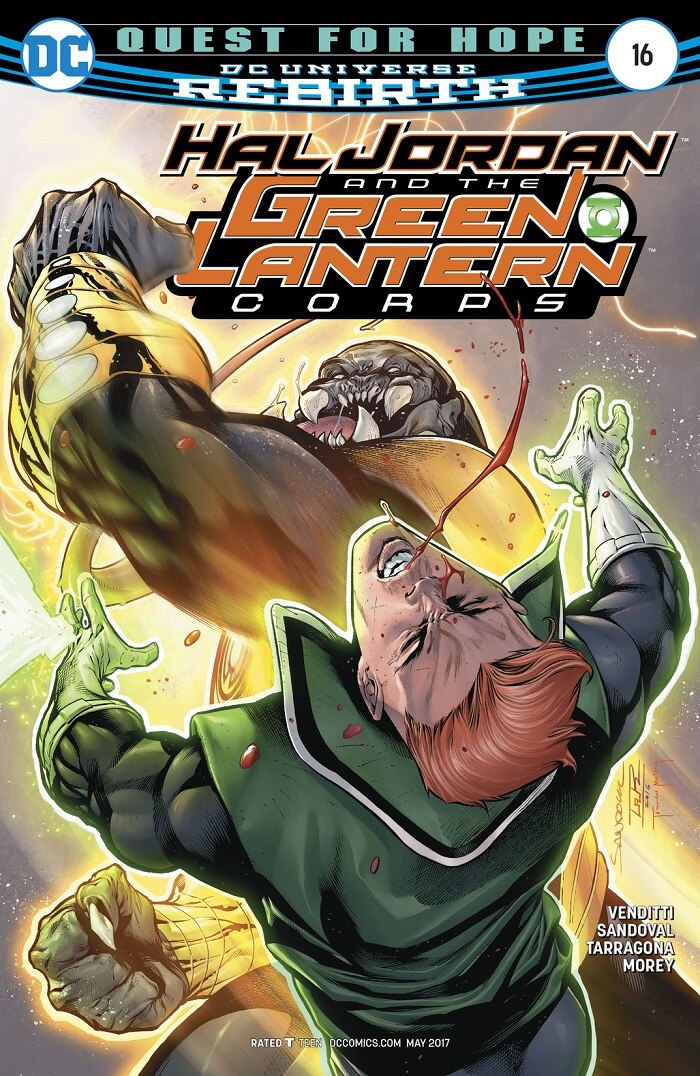
Jeff-Midnighter asks:
Thanagarians, Kryptonians, Kherubims, oh my. How many aliens have come, gone, or stayed on Earth?
Well, we’ve come a long way, Jeff, but here we finally are at the end of our alien survey. You can check the previous five editions of this column for the rest of our account of alien visitors to the planet that Superman and J’onn J’onzz call home, as well as all the necessary caveats and disclaimers which come with an undertaking such as this. Let it not be said that the Question avoids any case too big.
(Editor's note: But DCComics.com might. Consider this a friendly nudge saying that you're free to ask questions like this one in the future, and Alex may or may not answer them, but if he does, we probably won't be publishing those answers here on the DC site. They take up too much time and space and really limit the number of questions we're able to answer, so please try to keep your queries within reason going forward, DC fans! -Tired Out Tim)
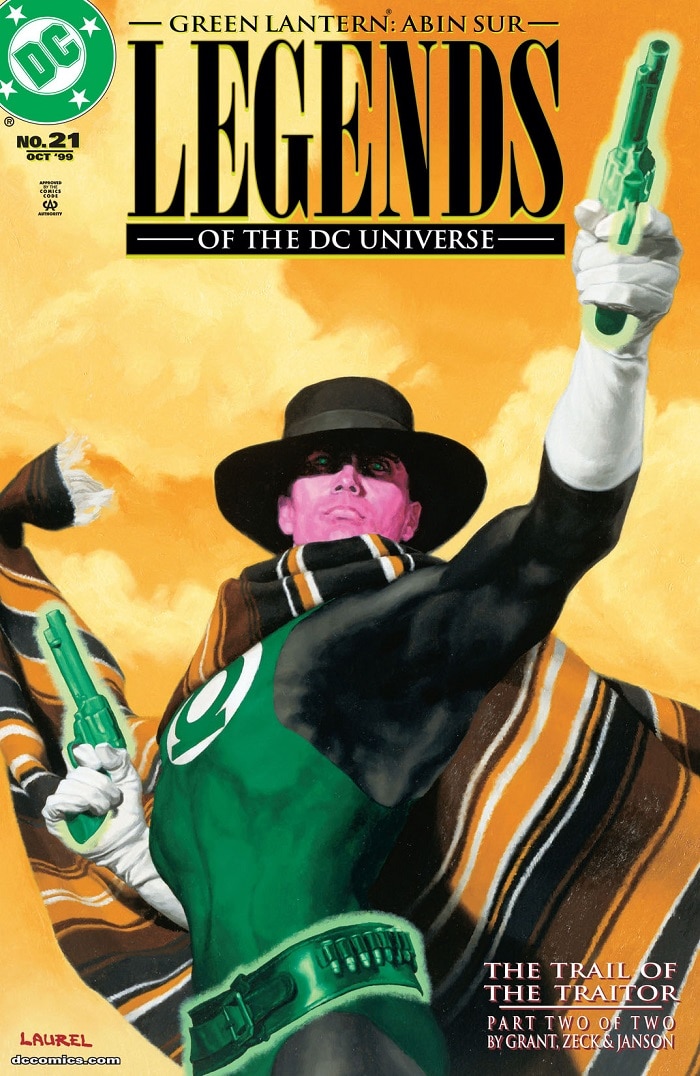
Ungarans: Red-skinned people of the planet Ungara. Prior to the appointment of Hal Jordan, the vast majority of Green Lanterns to patrol Sector 2814 were Ungarans. Abin Sur, Hal's predecessor, would often travel to Earth before his death in his official capacity.
Uranians: Like most non-human races assigned to our solar system, the people of Uranus were depicted with little consistency. In Golden Age Wonder Woman comics, the Uranians had plans to nuke Earth’s major cities and plunder the world of its uranium.
Valeronians: A technologically advanced people with a ’70s sci-fi aesthetic. Vartox, champion of Valeron, was a frequent visitor to Earth as a rival and friend to Superman, and later a suitor to Power Girl.
Velorpians: See "Czarnians."
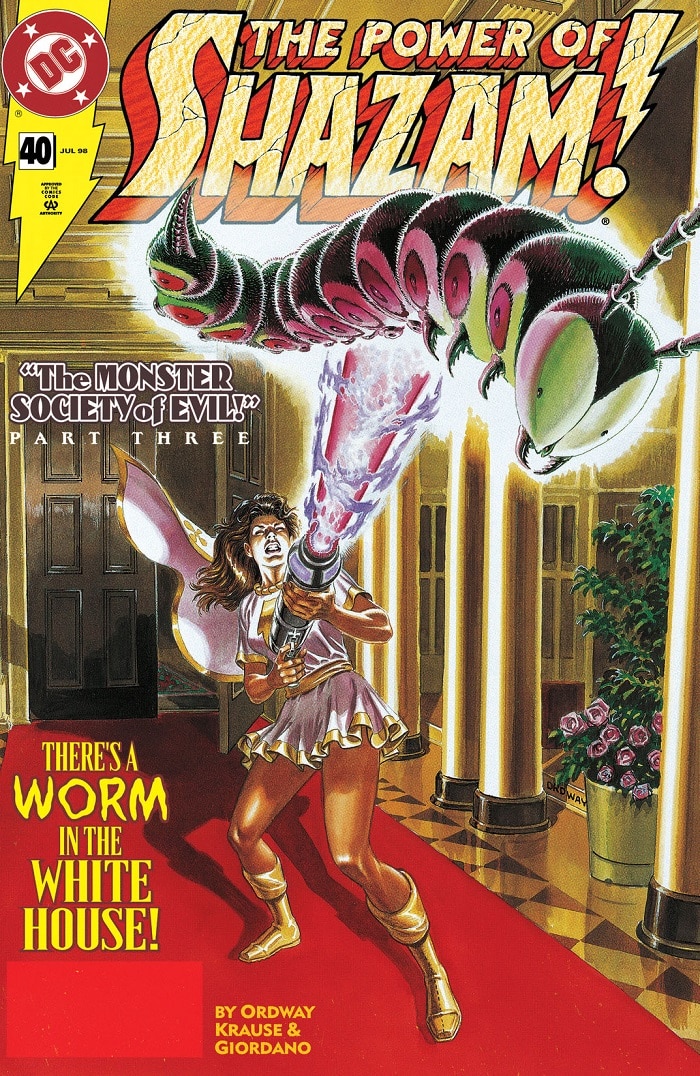
Venusians: Like the natives depicted on many planets in our solar system, the beings on Venus, particularly through the Golden Age, demonstrate little consistency. Some are humanoid, some decidedly less so. But Earth's most infamous Venusian resident is Mister Mind, the hyper-intelligent worm and sworn enemy of Captain Marvel.
Venturans: Big-headed, green-skinned, bulging-eyed people who kind of resemble the aliens from Mars Attacks! Venturans are a culture obsessed with gambling, and travel to Earth to place wagers on contests between the world’s resident metahumans, whether they be happenstance or engineered by the Venturans themselves.
Visionaries: Green-scaled race with winged ears and red segmented eyes, the Visionaries were a scientific race which developed a means of predicting the future. Sensing the "Great Disaster" to come in Earth's future, the Visionaries attempted to save the planet by initiating the OMAC Project, though their efforts ultimately proved futile.
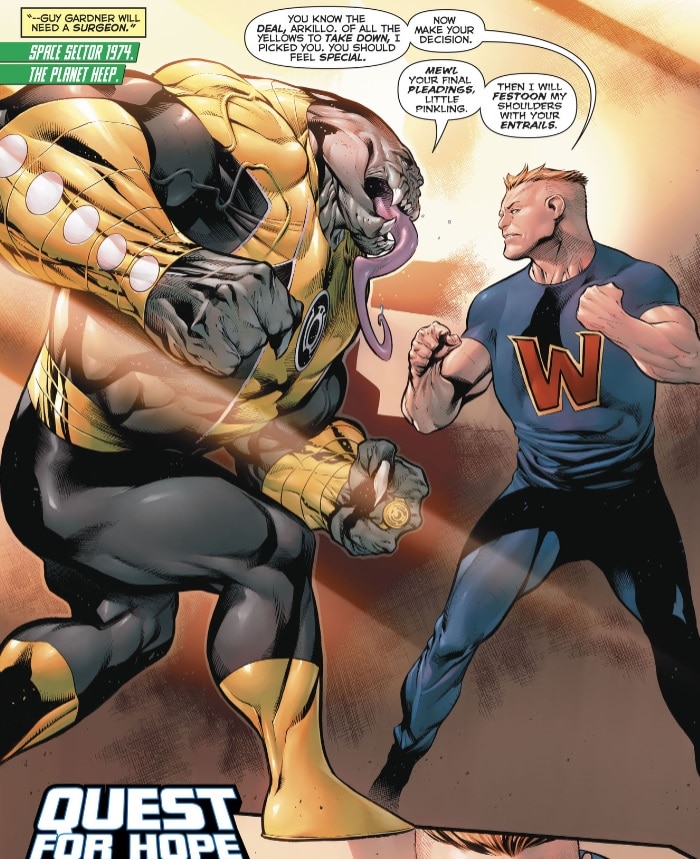
Vornians: A hairless, muscular, gray-skinned race with enormous teeth, the Vornian Arkillo has visited Earth many times as an emissary of the Sinestro Corps.
Vrangs: A pink-skinned, crumple-eared warrior race and ancient enemies of the Kryptonians. Millennia after being defeated on Krypton, the Vrangs came to Earth seeking vengeance on the planet's survivors.
Vuldarians: A warrior race known for grafting bioweapons onto themselves and sworn protectors of the universe from the Tormock Empire. In the ‘90s, Guy Gardner discovered that he had Vuldarian DNA.
Vyrgans: A blue, nonhumanoid intelligent race with birdlike heads, centipedal bodies, sharp pincer claws, and the ability to generate portals. One Vyrgan, "Gates," comes to Earth as a member of the Legion of Super-Heroes.
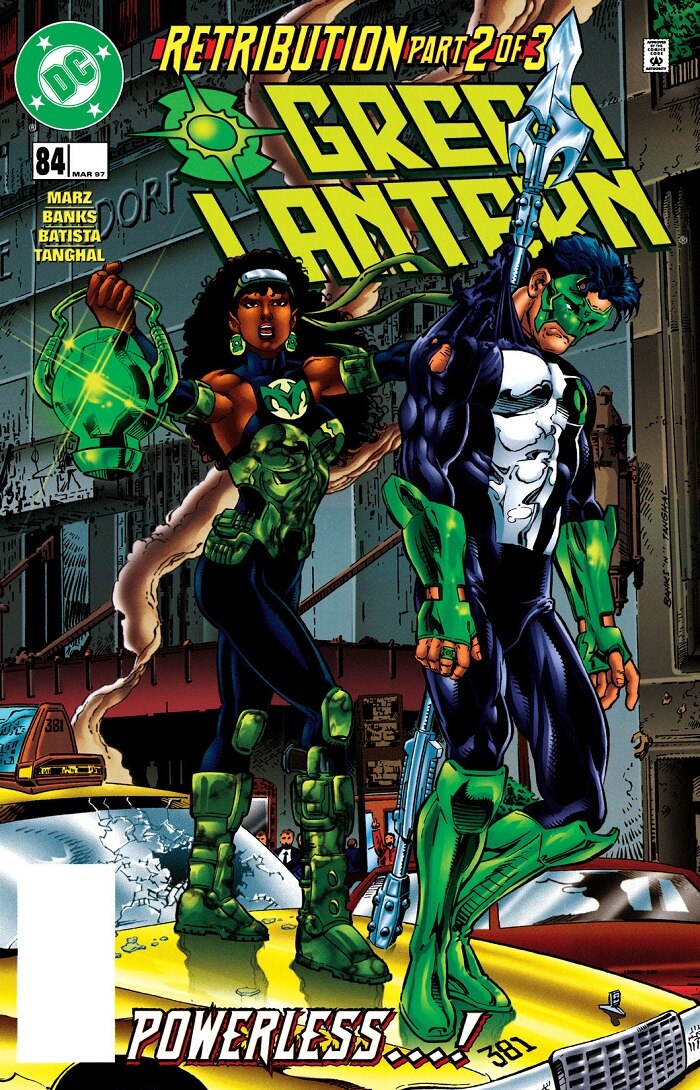
Xanshians: A humanoid race with superhuman abilities, including the power to detect weak points in beings and structures. The hubris of a rookie John Stewart infamously led to the destruction of Xanshi. A survivor, Yrra Cynril, has visited Earth to seek vengeance on the Green Lanterns as “Fatality.”
Xenusians: A demonic hawkbat race which spreads through the galaxy via a body-transforming plague. A Xenusian outbreak on Earth was thwarted by Hawkman.
Xudarians: An orange bird-like race from the planet Xudar, in our neighboring space sector 2813. Xudarian Green Lanterns, such as Tomar-Re, will pitch in to help with Earth's problems from time to time.
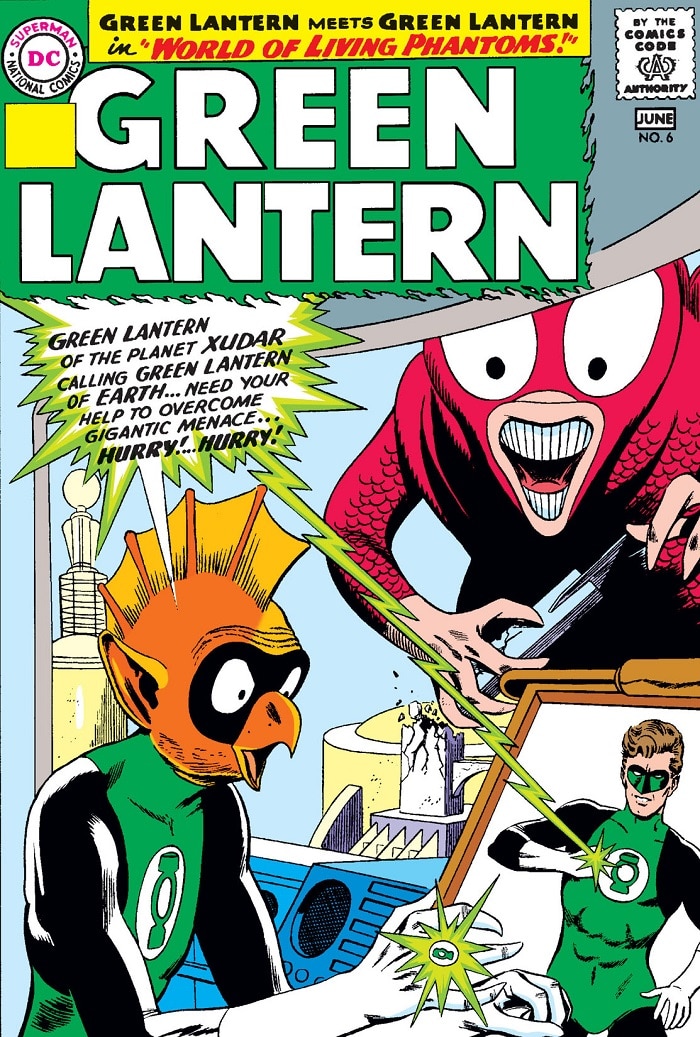
Zadronians: A peaceful humanoid race, known for their advanced medical and cybernetic technology. Tharok of the Fatal Five is one of the rare criminal Zadronians.
Zamarons: An all-female offshoot of the Maltusian race with their own ideas on how to best protect the universe. Founders of the Star Sapphires.
Zambaii: A hairless race with solid white eyes, the peaceful Zambaii had their world destroyed by alien raiders. One survivor, Ferrin Colos, was assigned to protect Earth as a member of the Darkstars.
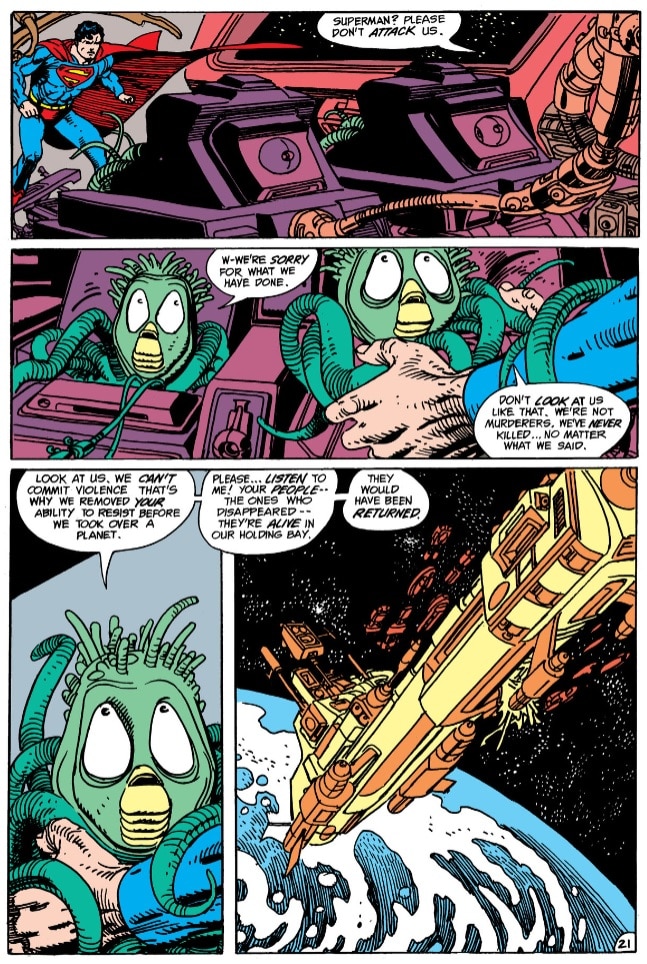
Zandrians: How to describe Zandrians... Kind of like Furbys, but with tentacles? Zandrians tried to conquer Earth by erasing the idea of Superman from existence using their Time Pyramids but were foiled when comic book creators Jerry Siegel and Joe Shuster rekindled the idea on their own in the altered timeline. You can read the whole story for yourself in Action Comics #554.
So, Jeff, that brings us to the end of the alphabet. To answer your original question of “how many aliens” have come, gone, or stayed on Earth: as a variety of species, hundreds. As individuals…they’re all around us.
What, Me Crossover?
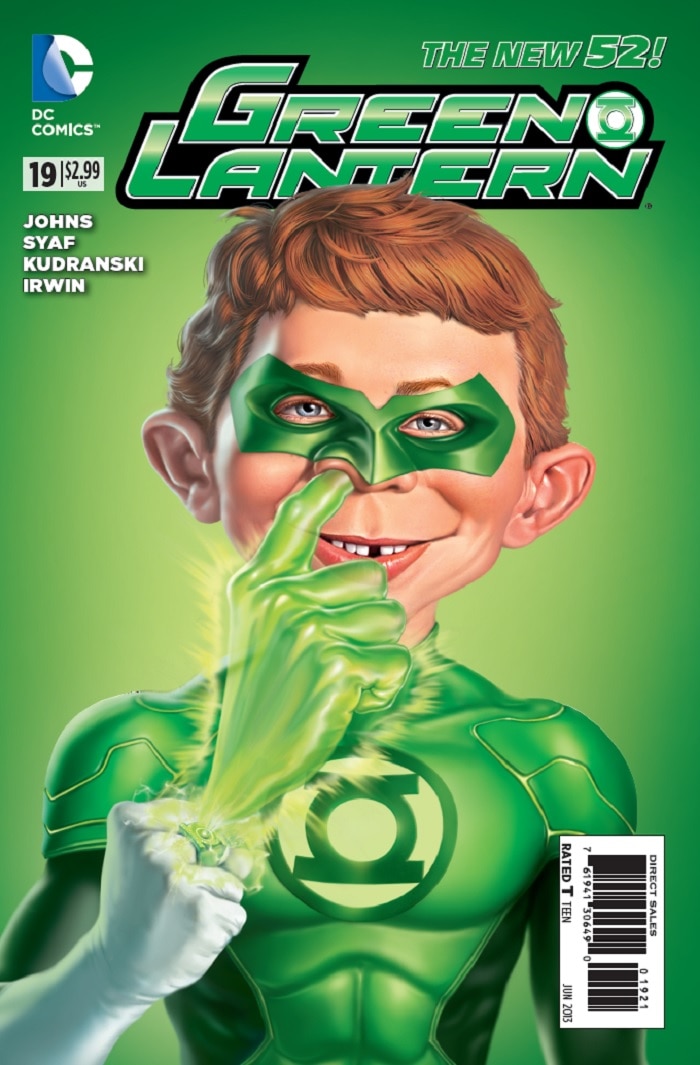
a2.ton.51072 asks:
I was recently thinking about some of the crossovers DC did in recent years with the other Warner Bros. imprints such as Hanna-Barbera and Looney Toons and I got to wondering, has Alfred E. Neuman or other MAD Magazine characters shown up in a mainstream DC Universe book?
As of this summer, we’ve never had the opportunity to see anything on the scale of, say, the Black and White Spy trading dynamite sticks with the Suicide Squad, or Roger Kaputnick handing in drafts of the Daily Planet funny page to Perry White. But I don’t want to turn you away without so much as a fold-in for your trouble. In 2013, DC did publish a line of thirteen variant covers all featuring MAD characters and iconic features. Not content to leave a gag well enough alone the first time, MAD and DC collaborated again in 2014, for twenty-one more covers featuring every Batman reader’s second-favorite Alfred. Here’s a selection of a few of our favorites.
As for interior work, I can offer you one treat: a pin-up page by MAD cartoonist Sergio Aragones himself from the 1998 DCU Holiday Bash special, where Alfred Neuman himself can be spotted from behind leading the JLA in a round of Christmas carols.
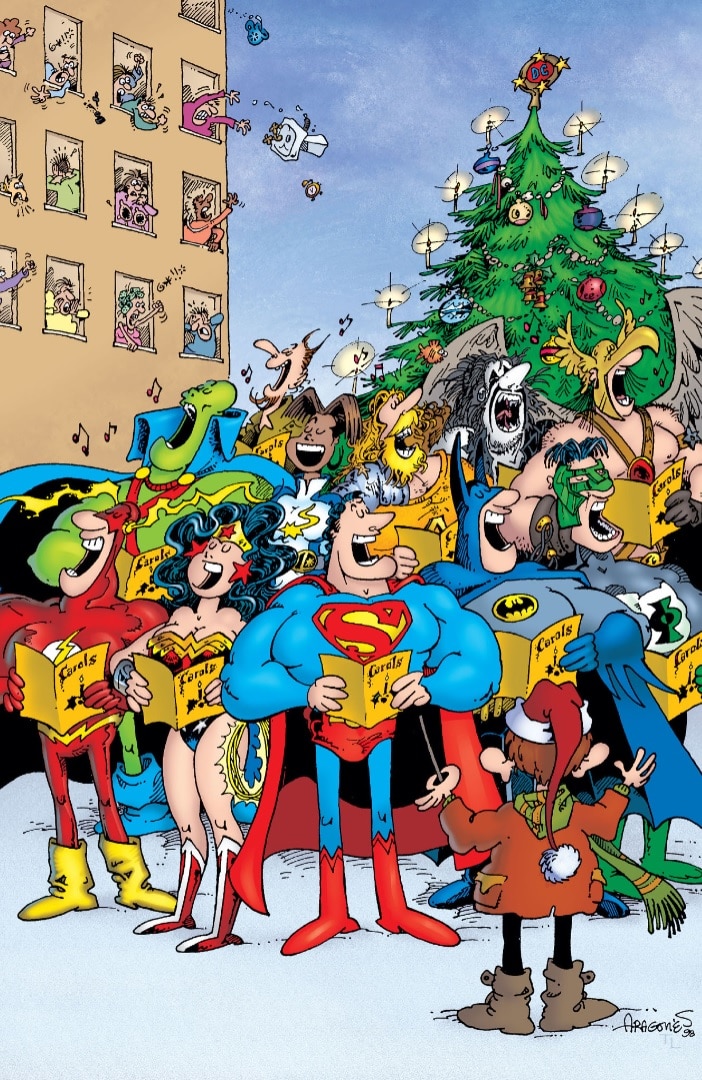
Sleeping Like a Stone
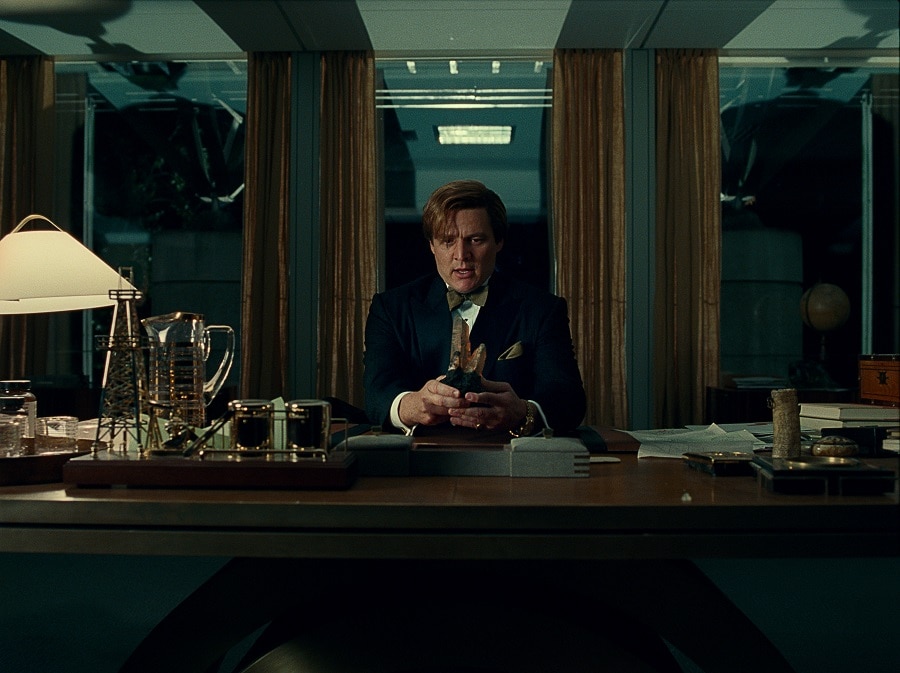
Wrightline1.42841 asks:
Patty Jenkins gave us a live action Max Lord and her version of the old Monkey’s Paw story in WW84. I assume said “paw” has appeared in the pages of DC prior to that film. Where and when?
This question requires a little bit of splicing to answer, because while the “Dreamstone” as it’s called in Wonder Woman 1984 does have comic origins, its wish-granting function as seen in the film is nothing at all like how it works in the original material. That “Monkey’s Paw” element is a Patty Jenkins invention.
Originally, the Dreamstone was the property of Justice League villain Doctor Destiny, as first seen in Justice League of America #19. Using the Dreamstone, Doctor Destiny had the power to project illusions in the minds of his victims. You’ll be seeing a more faithful depiction of this Dreamstone very soon, in a very different place. In The Sandman, the Dreamstone was revealed to actually be an artifact of great power belonging to Dream of the Endless, the spiritual embodiment of and ruler over all dreams. Dream’s conflict with Doctor Destiny over the fate of the Dreamstone is the climactic event in the first arc of The Sandman saga.
Why Jenkins chose to use the Dreamstone in Wonder Woman 1984 and bestow it with an entirely different function, I couldn’t say. Maybe she just liked the name.
Hair Today, Man of Tomorrow
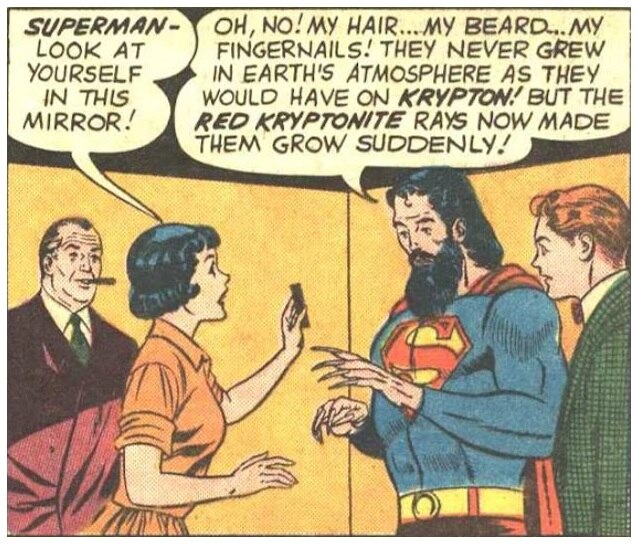
MatthewHecht asks:
In Lois & Clark: The New Adventures of Superman and Superman: The Animated Series, Superman shaves by reflecting his heat vision in the mirror. Does Clark shave like this in the comics?
I do like to revisit this question once in a while, as it’s one of the most popular questions people ask about Superman.
You may be surprised to learn that in the Silver Age, Superman didn’t have to shave at all. In 1960’s Superman #139, Red Kryptonite causes Superman’s hair and nails to start growing uncontrollably. Unable to trim them on his own, Superman explains that his hair and nails just stopped growing upon reaching a manageable length under the effects of Earth’s sun. It was in the Post-Crisis Man of Steel series by John Byrne that we’re given a more palatable explanation for Superman’s haircare routine, not too different from the mirror scheme seen on television. The difference is that instead of a regular mirror, Superman is shown using a piece of the spaceship which brought him to Earth to reflect his heat vision back onto his face.
Clark’s use of a mirror has since become more common as a visual shorthand, but does raise further questions. After all, if the heat vision is weak enough not to break the mirror, why would it be strong enough to cut his hair? These are the questions which Byrne’s spaceship solution was designed to answer.
Check the Clock… It’s Prime Time
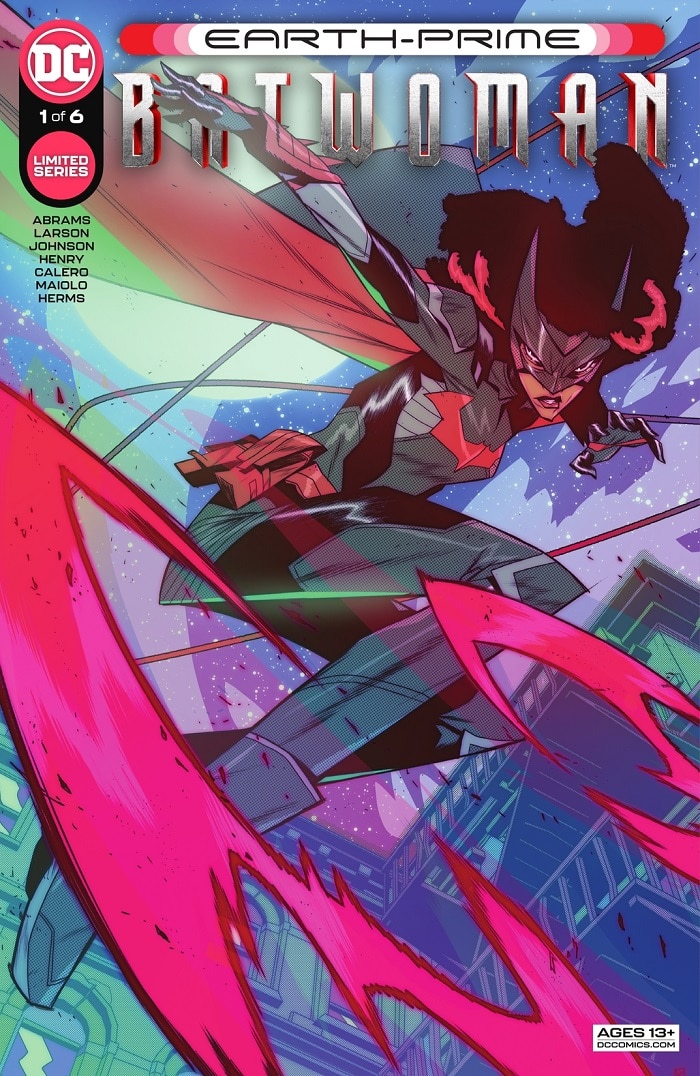
mhthomas33.10392 asks:
I am starting to get confused about the DC Multiverse. “Earth-Prime” seems to have several distinctions, but now seems to refer to the Arrowverse TV Universe? Also, what is the difference between Earth-0 and 1? And Earth-2 seems to be all over the place (the Earth-2 I loved was the New 52 Earth-2 with the “World’s End” storyline…) The rest I understand…but “Prime.” 0, 1 and 2 seem to be changing all the time…
No need to panic, Thomas. I understand your confusion. Let’s take a few deep breaths, and I promise we’ll try to make sense of all this together.
In 1961, a story called “Flash of Two Worlds” in The Flash #123 set up the designations of Earth-1 and Earth-2. Earth-1 was where the then-modern DC stories were said to take place, with the “Golden Age” stories of heroes like Jay Garrick and Alan Scott taking place on Earth-2. From there, an entire multiverse grew. One of the Earths introduced was “Earth-Prime,” which was meant to be our own reality, where superheroes were fictional characters in comic books. This was all until Crisis on Infinite Earths in 1985. The entire multiverse was (allegedly) destroyed, and all of reality as it was known in the comics was condensed into a single “New Earth.”
In 2007, it was revealed in the series 52 (not to be confused with The New 52, which came later) that the multiverse wasn’t destroyed after all, but reformed. “New Earth” was designated “Earth-0.” Earth-2, the home of the original Golden Age superheroes, was still out there. But Earth-1 was now the home of new updated versions of heroes such as those seen in the line of “Earth One” graphic novels.
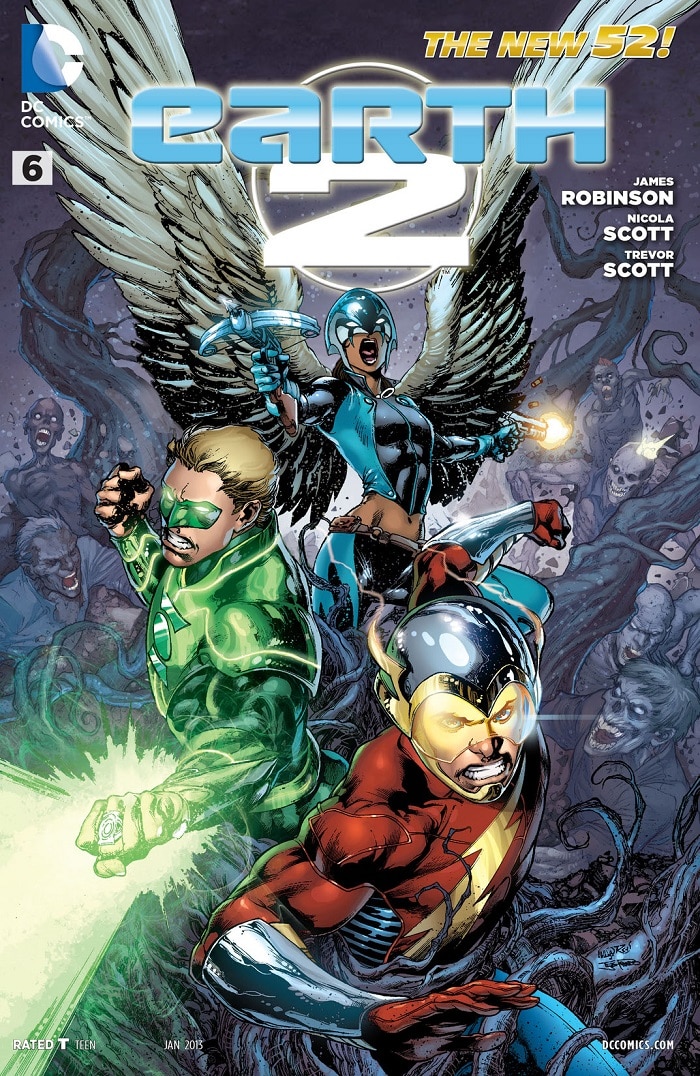
In 2011, the “Flashpoint” event reset the multiverse again. This time, “Earth-0” was synonymous with “Earth-Prime.” The “Earth-2” you read about in the New 52 was born, itself updating the classic Earth-2 stable of Golden Age heroes. And as the “Earth One” graphic novels were still being published, that remained Earth-1.
The multiverse as we see in The Flash and other Arrowverse shows, meanwhile, is treated as an entirely separate entity than the multiverse from the comics, and those Earth designations aren’t designed to be compatible with those we see in the books. In the CW family of superhero shows, their “Earth Prime” designation refers to the reconstituted reality following their own Crisis on Infinite Earths event cohabitated by Grant Gustin’s Flash, Melissa Benoist’s Supergirl, and many others. (Although, as recently revealed in the season two finale of Superman & Lois, not the characters on that show.)
I know that’s a lot to take in, but I’m always available for further questions and clarifications. If you need me, you can find me by following this link to the thread in the DC Community where I hold court.
That doesn’t just go for Thomas, but all of you out there reading this as well. It’s always a pleasure to see what comes through my door when you ASK… THE QUESTION.
Got something that's keeping you up nights? If you have a question about the DC Universe that you'd love to get answered, you can head on over to the DC Community and ask it here.
Alex Jaffe is the author of our monthly "Ask the Question" column and writes about TV, movies, comics and superhero history for DCComics.com. Follow him on Twitter at @AlexJaffe and find him in the DC Community as HubCityQuestion.
NOTE: The views and opinions expressed in this column are solely those of Alex Jaffe and do not necessarily reflect those of DC Entertainment or Warner Bros.




















